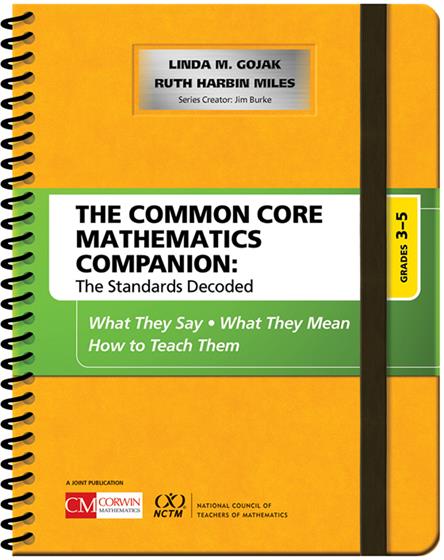Acknowledgments
Letter to Grades 3–5 Teachers
Letter to Elementary School Principals
Introduction
A Brief History of the Common Core
The Common Core State Standards for Mathematics
Instructional Shifts
Major Work of Grades 3¬–5
Common Core Word Wall
The Common Core Standards for Mathematical Practice
Effective Teaching Practices
How to Use This Book
Reflection Questions
Part 1. Operations and Algebraic Thinking
Domain Overview
Suggested Materials for This Domain
Key Vocabulary
Grade 3
Cluster A: Represent and solve problems involving multiplication and division.
Cluster B: Understand properties of multiplication and the relationship between multiplication and division.
Cluster C: Multiply and divide within 100.
Cluster D: Solve problems involving the four operations, and identify and explain patterns in arithmetic.
Sample Planning Page: Operations and Algebraic Thinking, Grade 3, Cluster A
Planning Pages
Grade 4
Cluster A: Use the four operations with whole numbers to solve problems.
Cluster B: Gain familiarity with factors and multiples.
Cluster C: Generate and analyze patterns.
Sample Planning Page: Operations and Algebraic Thinking, Grade 4, Cluster B
Planning Pages
Grade 5
Cluster A: Write and interpret numerical expressions.
Cluster B: Analyze patterns and relationships.
Sample Planning Page: Operations and Algebraic Thinking, Grade 5, Cluster A
Planning Pages
Reflection Questions: Operations and Algebraic Thinking
Part 2. Number and Operations in Base Ten
Domain Overview
Suggested Materials for This Domain
Key Vocabulary
Grade 3
Cluster A: Use place value understanding and properties of operations to perform multi-digit arithmetic.
Sample Planning Page: Number and Operations in Base Ten, Grade 3, Cluster A
Planning Page
Grade 4
Cluster A: Generalize place value understanding for multi-digit whole numbers.
Cluster B: Use place value understanding and properties of operations to perform multi-digit arithmetic.
Sample Planning Page: Number and Operations in Base Ten, Grade 4, Cluster B
Planning Pages
Grade 5
Cluster A: Understand the place value system.
Cluster B: Perform operations with multi-digit whole numbers and with decimals to hundredths.
Sample Planning Page: Number and Operations in Base Ten, Grade 5, Cluster B
Planning Pages
Reflection Questions: Number and Operations in Base Ten
Part 3. Number and Operations—Fractions
Domain Overview
Suggested Materials for This Domain
Key Vocabulary
Grade 3
Cluster A: Develop understanding of fractions as numbers.
Sample Planning Page: Number and Operations—Fractions, Grade 3, Cluster A
Planning Page
Grade 4
Cluster A: Extend understanding of fraction equivalence and ordering.
Cluster B: Build fractions from unit fractions by applying and extending previous understandings of operations on whole numbers.
Cluster C: Understand decimal notation for fractions, and compare decimal fractions.
Sample Planning Page: Number and Operations—Fractions, Grade 4, Cluster C
Planning Pages
Grade 5
Cluster A: Use equivalent fractions as a strategy to add and subtract fractions.
Cluster B: Apply and extend previous understandings of multiplication and division to multiply and divide fractions.
Sample Planning Page: Number and Operations—Fractions, Grade 5, Cluster A
Planning Pages
Reflection Questions: Number and Operations—Fractions
Part 4. Measurement and Data
Domain Overview
Suggested Materials for This Domain
Key Vocabulary
Grade 3
Cluster A: Solve problems involving measurement and estimation of intervals of time, liquid volumes, and masses of objects.
Cluster B: Represent and interpret data.
Cluster C: Geometric measurement: Understand concepts of area and relate area to multiplication and to addition.
Cluster D: Geometric measurement: Recognize perimeter as an attribute of plane figures and distinguish between linear and area measures.
Sample Planning Page: Measurement and Data, Grade 3, Cluster A
Planning Pages
Grade 4
Cluster A: Solve problems involving measurement and conversion of measurements from a larger unit to a smaller unit.
Cluster B: Represent and interpret data.
Cluster C: Geometric measurement: Understand concepts of angle and measure angles.
Sample Planning Page: Measurement and Data, Grade 4, Cluster A
Planning Pages
Grade 5
Cluster A: Convert like measurement units within a given measurement system.
Cluster B: Represent and interpret data.
Cluster C: Geometric measurement: Understand concepts of volume and relate volume to multiplication and to addition.
Sample Planning Page: Measurement and Data, Grade 5, Cluster C
Planning Pages
Reflection Questions: Measurement and Data
Part 5. Geometry
Domain Overview
Suggested Materials for This Domain
Key Vocabulary
Grade 3
Cluster A: Reason with shapes and their attributes.
Sample Planning Page: Geometry, Grade 3, Cluster A
Planning Page
Grade 4
Cluster A: Draw and identify lines and angles, and classify shapes by properties of their lines and angles.
Sample Planning Page: Geometry, Grade 4, Cluster A
Planning Page
Grade 5
Cluster A: Graph points on the coordinate plane to solve real world and mathematical problems.
Cluster B: Classify two-dimensional figures into categories based on their properties.
Sample Planning Page: Geometry, Grade 5, Cluster A
Planning Pages
Reflection Questions: Geometry
Resources
Table 1: Addition and Subtraction Situations, Grades 3–5
Table 2: Multiplication and Division Situations, Grades 3–5
Table 3: Standards for Mathematical Practice
Table 4: Effective Teaching Practices
CCSS Where to Focus Grade 3 Mathematics
CCSS Where to Focus Grade 4 Mathematics
CCSS Where to Focus Grade 5 Mathematics
Reproducibles
Additional Resources
About the Authors



